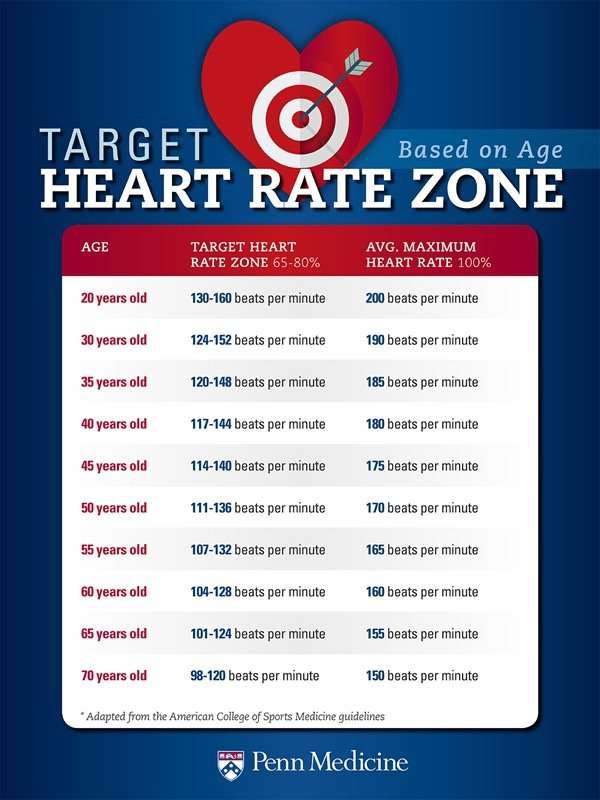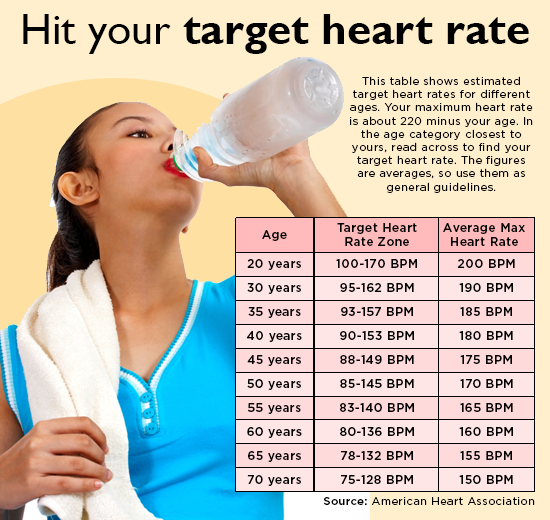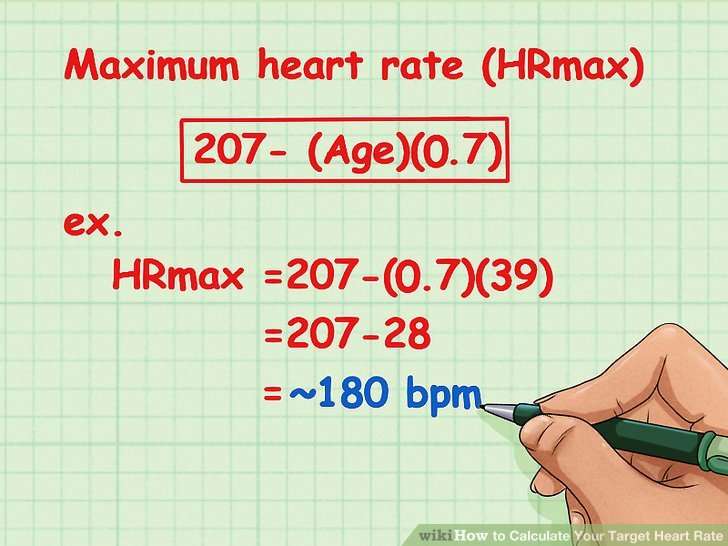Other Factors That Increase Your Heart Rate
In addition to exercise, there are other things that can increase your heart rate, including
stress, uncontrolled anxiety and poor sleep habits. These will all increase your adrenaline levels and your resting heart rate. Drinking caffeine and alcohol also will increase your resting heart rate.
Some medications or medical conditions, such as hyperthyroidism or anemia, can speed up your heart rate, and this means you may have a lower maximum heart rate and target heart rate zone.
Heart failure also can cause an abnormally elevated resting heart rate.
If the heart is not pumping as much blood each time it contracts for a variety of reasons, it will compensate for that fact by getting faster so that the total overall blood being pumped per minute is the same, Dr. Kelly says. If each pump yields less blood, then itll just pump faster so that the total amount of blood being pumped doesnt change.
If you have a heart condition or take medication for anemia or hyperthyroidism, ask your healthcare provider what your heart rate should be.
Does The Average Person Need To Track Their Heart Rate
If you have heart disease, its important to learn target heart rates and monitor them as you exercise. For everyone else, the talk test works just fine, says Travers. Can you talk and carry on a conversation when youre exercising? Then youre in a heart-healthy, moderately easy zone. Dont stress about the numbers.
What matters most is that you make an effort to move more. Any exercise, for any length of time, will improve fitness. If tracking your heart rate makes you happy, then go for it. But if heart rate calculations become a stumbling block, forget about it. Your journey to becoming stronger and healthier is too important to let anything get in the way.
Target Heart Rate And Estimated Maximum Heart Rate
One way of checking physical activity intensity is to determine whether your pulse or heart rate is within the target zone during physical activity.1
For moderate-intensity physical activity, your target heart rate should be between 64% and 76%1,2 of your maximum heart rate. You can estimate your maximum heart rate based on your age. To estimate your maximum age-related heart rate, subtract your age from 220. For example, for a 50-year-old person, the estimated maximum age-related heart rate would be calculated as 220 50 years = 170 beats per minute . The 64% and 76% levels would be:
- 64% level: 170 x 0.64 = 109 bpm, and
- 76% level: 170 x 0.76 = 129 bpm
This shows that moderate-intensity physical activity for a 50-year-old person will require that the heart rate remains between 109 and 129 bpm during physical activity.
For vigorous-intensity physical activity, your target heart rate should be between 77% and 93%1,2 of your maximum heart rate. To figure out this range, follow the same formula used above, except change 64 and 76% to 77 and 93%. For example, for a 35-year-old person, the estimated maximum age-related heart rate would be calculated as 220 35 years = 185 beats per minute . The 77% and 93% levels would be:
- 77% level: 185 x 0.77 = 142 bpm, and
- 93% level: 185 x 0.93 = 172 bpm
Recommended Reading: Can Acid Reflux Cause Palpitations
Age And Fitness Level Based Formula
This formula uses your age and fitness level to determine your target zones. It is a more personalized number and recommended for people who are experienced exercisers.;First, you must take your heart rate for three mornings in a row before getting up from bed. Once you have those numbers you can calculate their average by summing them and then dividing the sum by 3.
/ 3 = Morning Resting Heart Rate
This is the single best indicator of your state of fitness. Once you have this number established as a baseline, you can use it to understand more about yourself than you can imagine. Take it again every once in a while, at least once every two weeks. As your fitness improves, you will most likely see that number going down.;
If you see an elevated number, it could mean one or more of the following:
- You did not recover from a hard workout the day before
- You need more rest
- Your body has begun fighting off an oncoming illness
Your estimated maximum heart rate is 220 minus your age. In order to get your target heart rate zones you need to do the following calculations:
|
Heart rate zone |
What Is A Target Heart Rate Zone And How To Calculate Yours

One of the best ways to make training process more effective is to listen to your heart. Structuring sessions around a specific target heart rate zone will help to focus better on various areas of performance.
And get better results!
But what is target heart rate zone? What good does sticking to a specific target heart rate zone bring? And, most importantly, how to calculate heart rate zones?
Scroll down and learn
Also Check: Does Acid Reflux Cause Heart Palpitations
What Is Maximum Heart Rate
Your maximum heart rate is, on average, the highest your pulse can get. One way to get a rough estimate of your predicted maximum is to subtract your age from the number 220.
For example, a 40-year-old’s predicted maximum heart rate is about 180 beats per minute.
You can learn your actual maximum heart rate with a graded exercise test. If youâre taking medicines or have a medical condition such as heart disease, high blood pressure, or diabetes, ask your doctor whether you should adjust your exercise plan to keep your heart rate under a specific number.
How Can You Use Your Target Heart Rate
You can use your target heart rate to know how hard to exercise to gain the most aerobic benefit from your workout. You can exercise within your target heart rate to either maintain or raise your aerobic fitness level. To raise your fitness level, you can work harder while exercising to raise your heart rate toward the upper end of your target heart rate range. If you have not been exercising regularly, you may want to start at the low end of your target heart rate range and gradually exercise harder.
To take your heart rate during exercise, you can count the beats in a set period of time and then multiply by a number to get the number of beats per minute. For example, if you count your heartbeat for 30 seconds, double that number to get the number of beats per minute. You can also wear a heart rate monitor during exercise so you do not have to take your pulse. A heart rate monitor shows your pulse rate continuously, so you see how exercise changes your heart rate. Then you can work harder or easier to keep your heart working in your target heart rate range.
Target heart rate is only a guide. Each individual is different, so pay attention to how you feel, how hard you are breathing, how fast your heart is beating, and how much you feel the exertion in your muscles.
You May Like: List The Steps Of How To Calculate Your Target Heart Rate Zone
What To Do With All The Data
So there you have it. Once resting & maximum heart rates are known and each target heart rate zone is calculated, its important to sit down with your coach and create a plan that would contain the most optimal mix of intensities for you.
When done, its all about sticking to the plan during every training session and being mentally strong not to side step from it.
What Is Your Target Heart Rate
Your target heart rate has everything to do with how effective your body is at burning fat aka, a great workout tool. Its your hearts level of intensity, measured in beats per minute , at which your body can burn the most number of calories per minute.
In other words, knowing your target rate helps you know your hot zone. It gives you an idea as to how hard you should work out. Maybe you need to run a little faster, squat a little lower or make your routine a little longer. All of this, of course, is to make you more efficient at burning fat, strengthening your heart and managing your overall health.
Recommended Reading: How Much Can Marijuana Increase A Person’s Heart Rate
Measure Your Heart Rate
To determine your heart rate, use your first two fingers to press lightly over the blood vessels on your inner wristthe side by your thumb. Count your pulse for ten seconds and multiply this number by six.
If your heart rate is 50 to 85 percent of your maximum heart rate, you have hit your target heart zone and are working at the right level of intensity.
Wearing a multifunctional fitness tracker such as the Fitbit, or Nike+ FuelBand SE, does the work for you. The device is worn like a bracelet or watch and measures your heart rate.
Exercising at the right level of intensity improves heart and respiratory endurance and helps keep your workout at a level that is vigorous enough to meet your health goals.
What Things Affect Heart Rate
Other than exercise, things that can affect your heart rate include:
- Weather. Your pulse may go up a bit in higher temperatures and humidity levels.
- Standing up. It might spike for about 20 seconds after you first stand up from sitting.
- Emotions. Stress and anxiety can raise your heart rate. It may also go up when youâre very happy or sad.
- Body size. People who have severe obesity can have a slightly faster pulse.
- Medications. Beta-blockers slow your heart rate. Too much thyroid medicine can speed it up.
- Caffeine and nicotine. Coffee, tea, and soda raise your heart rate. So does tobacco.
Read Also: How Much Blood Does An Adult Heart Pump Every Day
Students Who Viewed This Also Studied
BIOGRAFIA BENEFICIOS Y CARACTERISTICAS INFO PRODUCTO.docx
Los Angeles City College
2 pages
Los Angeles City College HEALTH 011
95778783-Manual-Del-Celador-de-Instituciones-San-It-Arias.pdf
Los Angeles City College HEALTH 011
BIOGRAFIA BENEFICIOS Y CARACTERISTICAS INFO PRODUCTO.docx
Los Angeles City College HEALTH 011
Project vs. Operations Exercise.docx
Los Angeles City College HEALTH 011
Empowerment 1.edited.docx
Los Angeles City College HEALTH 011
Alexys_Martinez_-_Wutkee_-_Life_in_the_West_-_Part_2
What Are Exercise Heart Rate Zones

Heart rate zones are a percentage of your maximum heart rate . Exercise too close to your maximum HR and your heart and body will struggle to keep up with the demands.;
The goal of heart rate zones is to make you the most efficient, but to allow you to challenge yourself to improve cardiovascular fitness, says Travers.;;
Exercise heart rate zones are the training levels based on your maximum heart rate.;As you increase your pace, cadence and workload, you increase the demands on your heart. Travers breaks it down:;
- Lower-intensity zone:;Youre exercising at 50% to 60% of your max heart rate. At this point, 85% of the calories you burn are fat. The downside? Youre burning fewer calories overall than you would if you were exercising at a higher intensity. Youre generally able to sustain this zone the longest amount of time.
- Temperate zone:;Youre exercising at 60% to 70% of your max heart rate. Roughly 65% of the calories you burn are fat.
- Aerobic zone:;Working at 70% to 80% of your max heart rate puts you in the aerobic zone. About 45% of the calories you burn are fat. But youre burning a higher number of overall calories compared to the other heart rate zones. You generally sustain this zone the shortest amount of time.;
You May Like: Can Too Much Vitamin D Cause Heart Palpitations
Put That Heart Rate Monitor To Good Use With This Handy Guide Based On Age
The sweat is pouring and your heart is pounding.But how fast or, how many beats per minute should you shoot for while exercising? Amy Kleski, the Wellness Center Membership Manager at the McConnell Heart Health Center, recommends being aware of your heart rate targets, but not letting that be the only thing that determines your workout.
The main thing is for people to pay attention to how they feel. We want people to have an awareness of what their heart rate is and their heart rate zones, but not to rely on it so much that they lose sight of how they feel while theyre doing the work, because thats the biggest indicator of how youre doing overall.
What Is A Target Heart Rate Zone
The problem is that its not accurate to define intensity only as a percentage of maximum heart rate.
A heart rate zone is a defined range , yes, but people are not that straightforward.;Or;similar.
Heart rate zones differ from person to person due to a trainload of factors. Which is why absolute numbers dont matter.
We can do a killer sprint set or not get enough sleep one day and see our heart rate going bananas next morning. Overall stress level, hectic lifestyle, illness these are just some examples of factors that affect athletes fitness condition and, ultimately, heart rate zones.
To account for this, a so-called Target Heart Rate Zone is used. It takes into account both maximum and resting heart rates to determine an accurate zone reflecting athletes actual condition.
Don’t Miss: Thrz Calculator
How To Calculate Target And Maximum Heart Rates
You can calculate your target and maximum heart rates using the formula below.
To determine your maximum heart rate, subtract your age from 220. Your target heart rate zone is determined based upon your maximum heart rate. You want to stay within 5075 percent of your maximum heart rate during exercise, depending upon your fitness level.
To find your target heart rate, multiply your maximum heart rate by 0.50. This will give you the low range number.
Target Heart Rate Calculator
Ever ask yourself, “how do I find my target heart rate?” Finding your target heart rate is easy with our target heart rate calculator. Target heart rate calculation can be determined for any age and activity level, enabling you to use a heart rate monitor and get the most benefit from your workouts.
Don’t Miss: How Does Heart Disease Affect The Skeletal System
Target Heart Rate For Exercise
Your target heart rate is 50 to 85 percent of your maximum heart rate. It is the level at which your heart is beating with moderate to high intensity. To determine your maximum heart rate, take 220 and subtract your age.
Sustaining a workout at this pace improves cardiorespiratory endurance. So knowing your target heart rate helps you pace your workouts. Exercising at the right level of intensity will help you avoid burning out or wasting time with a workout thats not vigorous enough to help you meet your goals.
Food As Fuel Before During And After Workouts
Your body is your vehicle, so you have to keep your engine running when you work out. That means fueling up your body by eating the right foods and drinking the right fluids, in the right amounts at the right times.
The American College of Sports Medicine says, Adequate food and fluid should be consumed before, during, and after exercise to help maintain blood glucose concentration during exercise, maximize exercise performance, and improve recovery time. Athletes should be well hydrated before exercise and drink enough fluid during and after exercise to balance fluid losses.You dont have to adhere to a rigid schedule and there are no hard-fast rules, said Riska Platt, M.S., R.D., a nutrition consultant for the Cardiac Rehabilitation Center at Mount Sinai Medical Center in New York. But there are some things you should do before, during and after you work out.
You May Like: How To Calculate Max Hr
Understanding Your Target Heart Rate
Nearly all exercise is good. But to be sure youre getting the most fromyour workout yet staying at a level thats safe for you, you can monitorhow hard your heart is working.
Aiming for whats called a target heart rate can help you do this, says Johns Hopkins cardiologist;Seth Martin, M.D., M.P.H.;Think of it as the sweet spot between not exercising hard enough and overexerting.
How To Calculate Your Target Heart Rate Zone

If you are looking to train according to your heart rate, you will need to calculate your target heart rate. This can be done by using an online calculator or computing the information yourself. If you are looking to determine your target heart rate for vigorous activity, start by subtracting your age from 220.
Heart Rate Maximum = beats per minute
For example, if you are 60 years old, then your maximum heart rate will be 160. Next, calculate your resting heart rate by counting the beats per minute while at rest, preferably after waking but before getting out of bed. This number should be between 60 and 100 beats per minute for the average adult.
Subtract your resting heart rate from your maximum heart rate to calculate your heart rate reserve. If your resting heart rate is 70 and your maximum heart rate is 160, then your heart rate reserve will be 90. Multiply this number by 0.7 then add your heart rate reserve to find the lower end of your target heart rate zone, then by 0.8 and add the heart rate reserve to find the higher end of your target heart rate zone. For example, if your heart rate reserve is 90, then the lower end of the range should be 153 beats per minute, and the higher end should be 162 beats per minute.
Recommended Reading: How Accurate Is Fitbit Charge 2 Heart Rate
